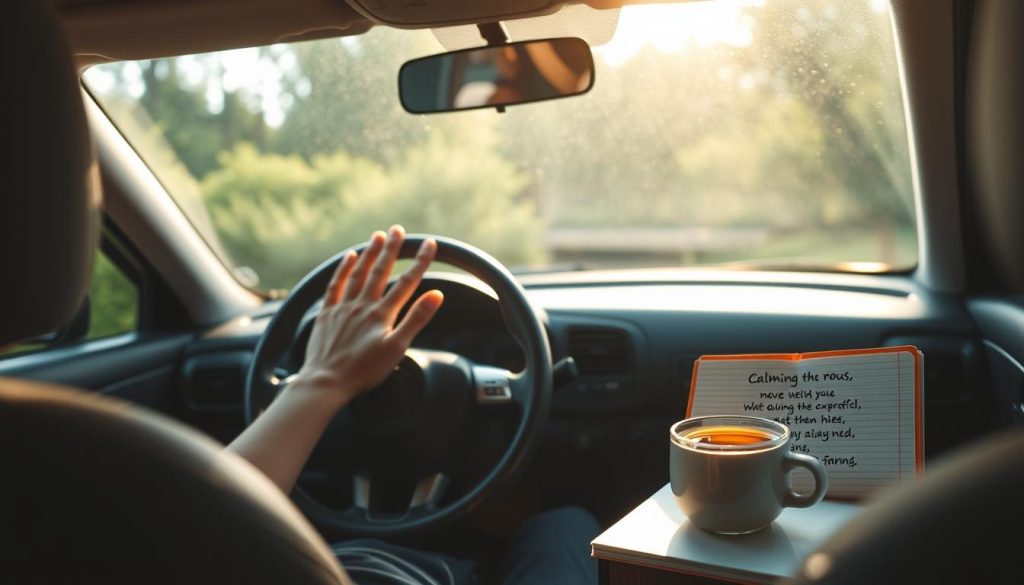anxietywhendriving.com highly recommends The Driving Fear Program to overcome your Driving Anxiety 90 Days Money Back Guarantee!
-->Click Here<--

Did you know over 20 million Americans have driving anxiety? It’s one of the most common phobias in the U.S. This fear can cause people to avoid driving, leading to panic attacks and affecting their daily lives. But, there’s hope. With the right strategies, you can overcome this fear and feel more confident driving.
Key Takeaways
- Driving anxiety is a common condition caused by factors like traumatic experiences, low blood sugar, and lack of exposure.
- Recognizing the physical and psychological symptoms of driving anxiety is the first step in addressing the problem.
- Preparing mentally and physically, gradually exposing yourself to driving, and facing your fears head-on can help you overcome your anxiety.
- Seeking professional help, such as therapy or driving lessons, can provide additional support and strategies.
- Developing self-belief, persistence, and defensive driving habits can further boost your confidence behind the wheel.
The Root Causes of Driving Anxiety
Driving anxiety can come from many sources. These include traumatic experiences on the road, blood sugar problems, and not being used to driving. Knowing what causes this fear is the first step to beating it.
Traumatic Driving Experiences
Being in or seeing a car accident can cause PTSD and a fear of driving. These scary events can make people feel anxious and unsafe while driving. It’s important to deal with these psychological effects to feel safe and in control again.
Low Blood Sugar and Hypoglycemia
Changes in blood sugar, especially low levels, can make people anxious and panic. Drivers might think these symptoms are because of driving, making their anxiety worse. Eating right and keeping blood sugar stable can help with this driving anxiety cause.
Avoidance and Lack of Exposure
Staying away from driving makes it harder to face fears. Not driving often can turn into a full-blown phobia. Slowly getting used to driving can help overcome these fears and build confidence.
Understanding the root causes of driving anxiety helps people face their fears. They can seek help, practice relaxation, or slowly build confidence. Overcoming driving anxiety is possible with the right steps.
Recognizing the Symptoms of Driving Anxiety
Driving anxiety shows up in many ways, affecting both body and mind. You might feel your heart racing, sweat a lot, or get really scared. These feelings can make it hard to drive confidently.
Physical Signs Like Increased Heart Rate and Sweating
When you’re anxious about driving, your body might react first. You could feel your heart beating fast, get sweaty palms, or have a dry mouth. This is because your body is getting ready to face stress.
This stress response can make it tough to stay focused. It might even raise the chance of accidents or close calls.
Psychological Distress and Panic Attacks
In serious cases, driving anxiety can lead to deeper emotional issues. You might feel panicked, confused, or like something bad is about to happen. You could also feel dizzy, have trouble breathing, or want to get away fast.
These feelings can really get in the way. They can make it hard to keep control of the car and react well to changes in traffic.
Knowing the symptoms of driving anxiety is key to finding ways to cope. It helps you feel more confident and safe on the road.
“The physical and psychological symptoms of driving anxiety can be overwhelming, but with the right approach, they can be managed and overcome.”
Preparing Mentally and Physically Before Driving
Overcoming driving anxiety starts with mental and physical preparation. Taking simple steps can greatly reduce anxiety and improve your driving. Focus on your mindset and physical health before you drive.
Eating a Balanced Diet
Your diet is key in managing driving anxiety. Eat foods rich in complex carbs, protein, and healthy fats. This helps keep your blood sugar stable, affecting your mood and energy.
Stay away from sugary and processed foods. They can cause blood sugar spikes and crashes. This can make you feel jittery and irritable.
Limiting Caffeine Intake
Too much caffeine can make anxiety worse. It can lead to a fast heartbeat and sweating. Try to cut down on caffeine, especially before driving.
This helps your body and mind relax and focus better.
Practicing Positive Self-Talk
How you talk to yourself matters a lot. Instead of negative thoughts, use positive self-talk and affirmations. Remind yourself of your driving skills and safety measures.
Believe in yourself and your ability to overcome driving anxiety. Positive thoughts can boost your confidence while driving.

By eating well, limiting caffeine, and using positive self-talk, you prepare better for driving. These steps help you feel more in control and less anxious on the road.
Gradual Exposure and Desensitization Techniques
Overcoming driving anxiety needs a step-by-step plan. Exposure Therapy and Desensitization Techniques are key in Overcoming Driving Fears. You start with easy situations and move to harder ones.
Begin by sitting in a parked car. Then, drive on quiet streets. Next, try busier roads and highways. Having someone you trust with you helps a lot.
- Start with small steps, such as sitting in a parked car and turning on the engine.
- Gradually increase the difficulty by driving on quiet, familiar roads.
- Gradually expose yourself to more challenging driving situations, like busy intersections or highways.
- Practice positive self-talk and relaxation techniques to manage anxiety during the process.
- Celebrate small victories and be patient with yourself as you work towards overcoming your driving fears.
The goal is to feel more comfortable and confident driving. With practice and facing your fears, you can enjoy driving again.
| Technique | Description | Benefits |
|---|---|---|
| Exposure Therapy | Gradually exposing the individual to the feared situation, starting with less threatening scenarios and gradually increasing the difficulty. | Helps the individual confront and overcome their fears, leading to increased confidence and reduced anxiety. |
| Desensitization Techniques | Involves the individual experiencing the feared situation in a controlled, safe environment, such as through visualization or role-playing, to reduce the emotional response. | Allows the individual to learn coping strategies and develop a sense of control over their anxiety, which can then be applied in real-world driving situations. |
“Facing your fears is the only way to truly overcome them. With patience and persistence, you can regain the freedom and joy of driving.”
Facing Your Fears Head-On
When tackling driving anxiety, facing your fears is key. Avoiding driving makes the fear worse. It’s important to keep driving, even when it’s hard, to build confidence.
Embracing Facing Driving Fears is tough, but it’s a must for Overcoming Avoidance. By facing your fears, you can get used to what scares you. This helps you take back control while driving.
- Start with short, easy drives and slowly get more comfortable.
- Use relaxation methods like deep breathing or positive thoughts to calm down.
- Celebrate your small wins. Seeing your progress boosts your confidence and drive.
“The only way to overcome your driving fears is to face them head-on. It may be uncomfortable at first, but with persistence and the right strategies, you can reclaim your freedom on the road.”
Facing your driving fears is hard, but with the right mindset and methods, you can do it. You’ll regain your confidence and control on the road.
Tips for Nervous Drivers
Driving can be scary for many people. But, with some helpful tips, you can feel safer and more at ease. Let’s look at some ways to help you face your driving fears.
Avoiding Stressful Driving Situations
One important step is to avoid stressful driving situations. This means staying away from busy times, heavy traffic, and unknown areas. By planning your trips and choosing less busy routes, you can ease your nerves.
Choosing Safe and Familiar Routes
Knowing your way around can make driving easier. Stick to routes you’re familiar with. This way, you’ll feel more comfortable and secure. Don’t try new things like driving in new places or on highways until you’re more confident.
Emotion Management and Relaxation Strategies
- Try deep breathing to calm down before and during your drive.
- Listen to calming music or podcasts to keep your mind focused.
- Use positive self-talk to remind yourself of your driving skills.
By using these Tips for Nervous Drivers, you can start to feel more confident on the road. Remember, it’s okay to take things slow. Celebrate every small success on your journey.

Seeking Professional Help
For those with driving anxiety, getting professional help can change everything. If tips and techniques don’t work, it’s time to look into therapy and special driving lessons. These can help tackle the root causes and boost confidence while driving.
Therapy Options Like CBT and Hypnotherapy
Cognitive-Behavioral Therapy (CBT) is a top choice for driving anxiety. It helps people face and change negative thoughts and beliefs. Hypnotherapy also helps, by using deep relaxation and guided images to tackle anxiety’s hidden causes.
Driving Lessons and Refresher Courses
Another great option is special driving lessons or refresher courses. These offer one-on-one support to build skills and confidence. Whether it’s a full course or focused sessions, these driving lessons are key to beating driving anxiety.
| Therapy Option | Description |
|---|---|
| Cognitive-Behavioral Therapy (CBT) | Helps individuals identify and challenge negative thoughts and beliefs, replacing them with more positive perspectives. |
| Hypnotherapy | Allows individuals to access and address the subconscious drivers of their anxiety through deep relaxation and guided visualization. |
“Seeking professional help was the turning point in my journey to overcome driving anxiety. The combination of therapy and specialized driving lessons gave me the tools and confidence I needed to reclaim the freedom of the open road.”
The Importance of Self-Belief and Persistence
Overcoming driving anxiety is tough, but it’s doable with the right mindset. You need strong self-belief and persistent effort to get back on the road.
Those who beat driving anxiety share a key trait: they believe in themselves. They face their fears head-on, not letting anxiety control them.
“I knew that if I wanted to regain my confidence and independence as a driver, I had to push past the fear and self-doubt. It wasn’t easy, but I kept reminding myself that I had the skills and resilience to overcome this obstacle.”
Persistence is key in overcoming driving anxiety. Becoming a confident driver takes time, but every small step helps. You build momentum and fight your fears.
- Practice positive self-talk and affirmations to cultivate a mindset of resilience and determination.
- Gradually expose yourself to driving situations, starting with low-stress environments and gradually building up your confidence.
- Celebrate your progress, no matter how small, and use each accomplishment as fuel to keep moving forward.
The path to beating driving anxiety isn’t straight, but with self-belief and persistent effort, you can overcome your fears. You’ll take back your rightful place behind the wheel.
Defensive Driving and Safety Habits
Being a responsible driver means knowing the latest traffic laws and road signs. This knowledge helps you follow rules and stay safe on the road. It also reduces stress and anxiety while driving.
Staying Up-to-Date with Traffic Laws and Road Signs
It’s important to know the traffic laws and what road signs mean. Reviewing your state’s driver’s manual or taking a refresher course is a good idea. It keeps you informed and ready for different driving situations.
Maintaining a Safe Distance and Signaling Properly
Keeping a safe distance from the car in front is key. It lets you react fast in emergencies and shows you care about others. Also, always use your turn signals to let others know where you’re going.
By following these defensive driving tips, you’ll feel more confident and calm while driving. Being prepared and alert makes you feel safer and more in control.
| Safety Habit | Description |
|---|---|
| Staying Up-to-Date with Traffic Laws | Regularly reviewing your state’s driver’s manual or taking a refresher course to stay informed about the latest traffic regulations. |
| Recognizing Road Signs | Familiarizing yourself with the meaning and significance of various road signs to enhance your situational awareness. |
| Maintaining a Safe Following Distance | Leaving enough space between your vehicle and the one in front of you to react quickly in case of an emergency. |
| Signaling Properly | Using your turn signals when changing lanes or making turns to communicate your intentions to other drivers. |
“Defensive driving is not just a skill, it’s a mindset that prioritizes safety and preparedness on the road.”
Overcoming Driving Anxiety Through Knowledge and Support
Driving anxiety can seem like a huge challenge. But, with the right knowledge and support, it’s conquerable. Many people with driving anxiety feel alone, not knowing others face the same issues. By understanding the causes and finding effective strategies, drivers can regain their confidence and freedom.
Seeking out information and resources is a crucial step in overcoming driving anxiety. Reading articles, watching videos, or joining online groups can help. Learning about the physical and mental factors behind driving anxiety empowers individuals to find their own solutions.
Having a strong support network also plays a big role. Talking to trusted friends, family, or a therapist can offer validation and encouragement. These people can provide advice, reassurance, and a listening ear, helping to ease the burden of anxiety.
“With the right information and a supportive network, drivers can overcome their anxiety and reclaim the freedom and independence that comes with being behind the wheel.”
By combining knowledge and support, individuals can create a solid plan to overcome driving anxiety. This approach helps drivers face their fears, use coping techniques, and build confidence and skills for easy navigation.
Conclusion
Overcoming driving anxiety is a journey of self-discovery and perseverance. It starts with understanding the causes and symptoms. Then, by using a comprehensive approach, nervous drivers can regain their confidence.
They can prepare mentally and physically. Gradually facing their fears helps. Getting professional help when needed is also key.
Drivers can face their anxieties and overcome driving anxiety. With persistence and a positive mindset, they can feel empowered and in control. They can learn defensive driving and stay informed about traffic laws.
By doing this, nervous drivers can change how they feel about driving. They can start to enjoy the journey instead of fearing it.
The journey to overcome driving anxiety is not easy. But the rewards are worth it. Drivers can regain their independence and self-assurance.
By using the strategies and tools from this article, drivers can overcome their fears. They can build resilience and find joy and confidence in driving.
FAQ
What are the root causes of driving anxiety?
Driving anxiety can stem from scary experiences on the road, like being in a car accident. It can also come from low blood sugar or not getting used to driving. This can lead to avoiding driving and even a full-blown phobia.
What are the common symptoms of driving anxiety?
Symptoms include a fast heart rate, sweaty palms, and feeling dizzy. You might also breathe short and feel dry in the mouth. For those with a phobia, it feels like they’re losing control or might die.
How can I prepare mentally and physically before driving?
Eat well and avoid sugary foods and too much caffeine. Use positive thoughts and affirmations to fight negative ones.
What are some gradual exposure and desensitization techniques for overcoming driving anxiety?
Start by sitting in a parked car. Then, drive on quiet roads. Gradually face more challenging situations. A driving instructor or family member can help.
Why is it important to face my driving fears head-on?
Avoiding driving makes fear worse. It’s key to face your fears and keep driving, even if it’s hard. This builds confidence and fights anxiety.
What tips can I use to manage my driving anxiety?
Avoid stressful driving times and choose safe routes. Use deep breathing and music to calm down. These strategies help manage nerves while driving.
When should I seek professional help for my driving anxiety?
If tips don’t work, seek help. Therapy like CBT or hypnotherapy can help. Driving lessons or courses also boost confidence and skills.
How important is self-belief and persistence in overcoming driving anxiety?
Believing in yourself and persisting are crucial. The journey may take time, but with the right mindset, you can become a confident driver.
What defensive driving habits can help reduce stress and increase safety on the road?
Stay updated on traffic laws and signs. Keep a safe distance from other cars. Always signal when turning or changing lanes.
How can gaining knowledge and seeking support from others help overcome driving anxiety?
Knowing the causes and strategies for managing anxiety helps. Support from friends and family who’ve faced similar issues makes you feel less alone. It helps regain confidence and freedom on the road.
anxietywhendriving.com highly recommends The Driving Fear Program to overcome your Driving Anxiety. 90 Days Money Back Guarantee!
-->Click Here<--


